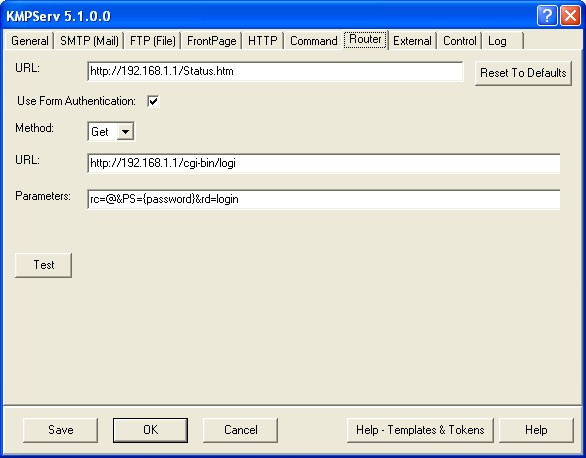
The Router tab is used for router configuration. It will only show if one of the supported external routers is selected in the "General" tab.

or

URL - the URL to load in order to obtain the external address.
[Reset To Defaults] - reset the router settings to the defaults provided to the author.
Use Form Authentication - whether to use standard or form authentication when querying the router. Most routers use a standard authentication method, which provides a popup dialog box when requesting the account and password information. However, some routers use a web form in order to authenticate the user. KMP allows for either authentication method.
For Standard Authentication:
Account/Password - used in authentication to the router. Note that the password will not display in the form, but will be stored in the registry in plain text format. This may be a security problem for some people.
For Form Authentication:
Method - form submission method ("Get" or "Post").
URL - the URL of the form processor.
Parameters - the parameters expected by the form processor.
Note:
Each router has its own standard URL that displays the address. Here are the defaults for each router, as provided to the author:
| Router | URL | Form Authentication | ||
|---|---|---|---|---|
| Method | URL | Parameters | ||
| 3Com Home Ethernet | http://192.168.2.1/status.htm (unconfirmed) | |||
| 3Com OfficeConnect 3C855 | http://192.168.1.1/main/status_admin.htm | |||
| Alcatel | http://10.0.0.138/ip.htm | |||
| Alcatel Speed Touch Pro | http://10.0.0.138/cgi/cli/ip/aplist | |||
| Belkin F5D7230-4 | http://192.168.2.254/ | |||
| D-Link DI-604 | http://192.168.0.1/st_devic.html | |||
| D-Link DI-614+ | http://192.168.0.1/st_devic.html | |||
| D-Link DI-624 | http://192.168.0.1/st_devic.html | |||
| Linksys | http://192.168.1.1/Status.htm | |||
| Linksys (Cisco) | http://192.168.1.1/Status_Router.htm | |||
| Linksys BEFW11S4 V4 | http://192.168.1.1/RouterStatus.htm | |||
| Linksys W11S4PC11 | http://192.168.1.1/RouterStatus.htm | |||
| Linksys WRT51AB | http://192.168.1.1/st_dhcp_dhcp.htm | |||
| Linksys WRT54G | http://192.168.1.1/Status_Router.asp | |||
| Linksys WRT54G - Wireless | http://192.168.1.1/Status_Router.asp | |||
| Linksys WRT54G PPOE | http://192.168.1.50/Status_Router.asp | |||
| Linksys WRT54GS | http://192.168.1.1/Status_Router.asp | |||
| Linksys WRT55AG | http://192.168.1.1/Status.htm (?) | |||
| Linksys WRV54G | http://192.168.1.1/SetupDHCP.htm | |||
| Microsoft MN-100 | http://192.168.2.1/home.htm | Post | http://192.168.2.1/login.htm | page=login&pws={password} |
| NetGear | http://192.168.0.1/mtenSysStatus.html | |||
| NetGear FR114P | http://192.168.1.1/s_status.htm | |||
| Netgear MR814v2 | http://192.168.0.1/s_status.htm | |||
| NetGear Prosafe FVS318 | http://192.168.0.1/sysstatus.html | |||
| NetGear RP614 | http://192.168.0.1/mtenSysStatus.html (?) | |||
| NetGear RP614v2 | http://192.168.0.1/sysstatus.html | |||
| NetGear WGT624 v2 | http://192.168.0.1/RST_st_dhcp.htm | |||
| Network Everywhere (NR041) | http://192.168.1.1/st_dhcp.htm | |||
| Sitecom | http://192.168.0.1/st_dhcphtm | |||
| SMC Barricade (R1.40) | http://192.168.2.1/status.HTM | |||
| SMC Barricade (Firmware 1.94c) | http://192.168.0.1/status.htm | |||
| SMC Barricade 7004VBR | http://192.168.2.1/status.htm | Post | http://192.168.2.1/cgi-bin/logi | rc=@&PS={password}&rd=login |
| SMC Barricade 7004VWBR/ABR | http://192.168.2.1/status_main.stm | Post | http://192.168.2.1/cgi-bin/login.exe | pws={password} |
| Solwise SAR 715+ | http://192.168.7.1/status/atm_channel.html?ImServices.ppp-0.1.ImChannels.item0 | |||
| SpeedStream 2601 | http://192.168.0.1/st_dhcp.htm | |||
| SpeedStream 2614 | http://192.168.0.1/st_dhcp.htm (?) | |||
| SpeedStream 2624 | http://192.168.0.1/st_dhcp.htm (?) | |||
| UMax | http://192.168.1.1/Status.htm (unconfirmed) | |||
| USR 8000A | http://192.168.123.254/status.htm | |||
| USR 8022 | http://192.168.123.254/status.htm | Post | http://192.168.123.254/cgi-bin/logi | rc=@&PSW={password}&rd=menu&Submit1=Log+in |
| USR 8054 | http://192.168.123.254/status.htm | |||
| Zoom X3 | http://10.0.0.2/doc/wan.htm | |||
If your router is not yet on the list, consider contacting the author to have it added. Also, if you find the above information incorrect, or can confirm any of the unconfirmed addresses, please contact the author to provide corrections.
KMP now supports UPnP. It is important to note, however, that UPnP is still in its infancy. Manufacturers do not yet seem to be implementing it consistently. So, whereas the router manufacturer may claim to support UPnP, KMP may still not work with it correctly.
UPnP is used in two parts of the process: finding the router, and obtaining the external (WAN) IP address. UPnP makes it easy for KMP to find the router without any of the usual information otherwise necessary. It should be unnecessary to supply the URL. Hitting the [Discover] button should find the URL needed by the rest of the UPnP process. You may hit [Discover] once and have the settings saved, or you may ask KMP to try to discover the router each time it runs through a loop. Alternatively, if [Discover] does not work, but you know the URL of the root description document, you may enter it into the URL.

URL - the URL to the root description document. It should not be necessary to supply this information, since the discovery process should be able to find it. However, if discovery fails, this address can be entered manually (if known).
Account/Password - used in authentication to the router. Many routers do not require these entries when using UPnP. Note that the password will not display in the form, but will be stored in the registry in plain text format. This may be a security problem for some people.
Location - the URL to the WANIPConnection device. It should not be necessary to supply this information, since the discovery process should be able to find it. However, if discovery fails, this address can be entered manually (if known).